Ageing and sexing details:
|
JAN - JUL: after-second-year
unknown |
Overall plumage is similar across ages and sexes in spring. While molt limits may be sufficiently visible on some SY birds when perched, the absence of an apparent limit is not enough to consider an individual as ASY. Similarly, ASY birds tend to have fewer black streaks on the crown, but only extreme cases are reliable for ageing. While males may be somewhat brighter, especially on the crown, differences are again generally too subtle to be reliable.
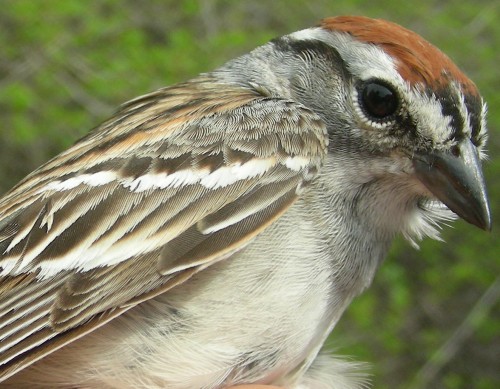
Photo by Marie-Anne
Hudson, McGill Bird Observatory (QC), May 2007
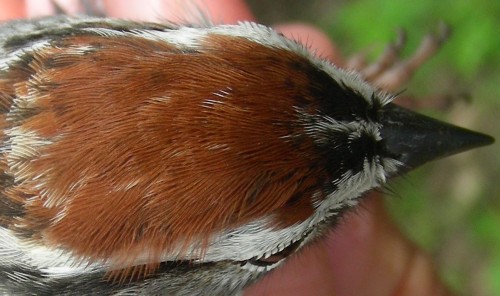
A view of the crown of the bird above, showing a mostly uniform rusty cap.
Photo by Marie-Anne
Hudson, McGill Bird Observatory (QC), May 2007
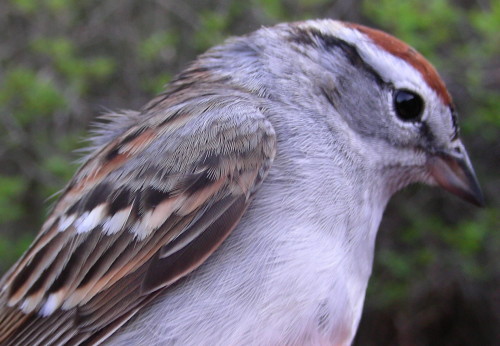
Photo by Marie-Anne Hudson,
McGill Bird Observatory (QC), May 2009
The overall appearance of ASY wings can be quite variable, including some that are quite faded and worn, but the key is to look for a uniform pattern across the wing, i.e. the absence of a molt limit.
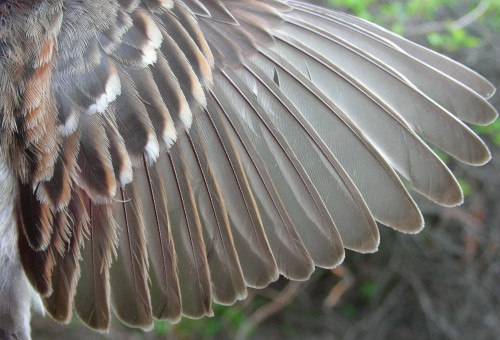
This wing is in good condition, with only moderate wear showing on the inner secondaries.
The outer primaries are broad and rounded, and the primary coverts are rounded and
showing rusty edging.
However, many ASY wings are not in such good condition.
Photo by Marie-Anne Hudson,
McGill Bird Observatory (QC), May 2009
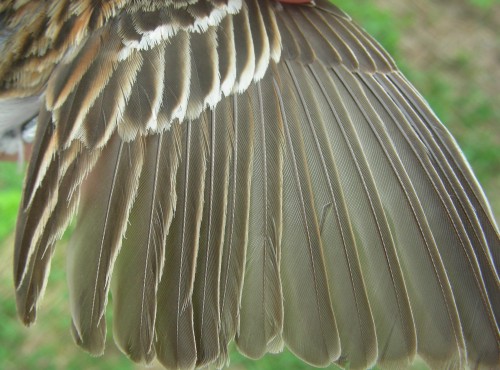
A somewhat more worn wing, paler overall and with less edging on the primary coverts,
but still overall fairly uniform in appearance.
Photo by Marie-Anne
Hudson, McGill Bird Observatory (QC), May 2007
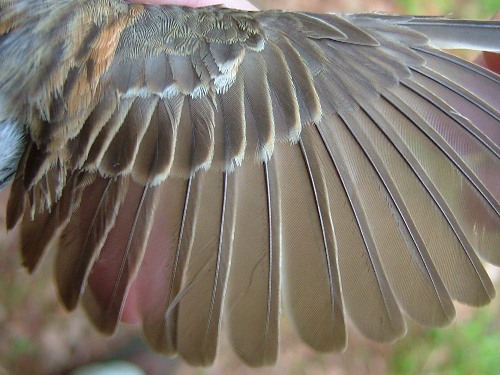
A particularly worn ASY wing, especially the median coverts, greater coverts, and inner
secondaries. Note a complete lack of edging to the primary coverts, but that overall the
colour tone and condition of the wing is still relatively uniform.
Photo by Peter Pyle, Howell Woods (NC), May 2006
Chipping Sparrows of all ages
have relatively narrow rectrices, but those of ASY birds are on average
broader and more rounded at the tip than those of SY birds;
nevertheless, tail shape should be used only in combination with other
ageing criteria.
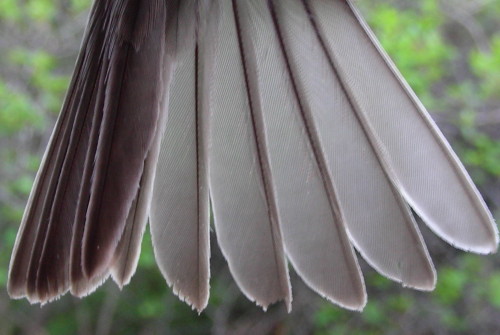
A relatively typical ASY tail, showing some wear at the tips of feathers, but overall
comparatively broad, rounded, and in good condition for a Chipping Sparrow.
Photo by Marie-Anne Hudson,
McGill Bird Observatory (QC), May 2009
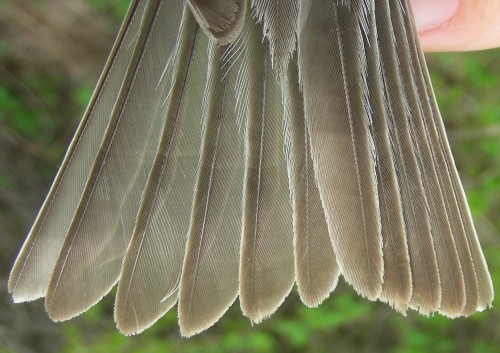
Another example of a similar pattern, but with a somewhat paler colour tone.
Photo by Marie-Anne
Hudson, McGill Bird Observatory (QC), May 2007
RETURN TO AGE/SEX
OVERVIEW
|
JAN - JUL: second-year
unknown |
Occasionally molt limits on the wing are distinct enough on SY birds to be seen while perched, and some may also have distinct black streaks in the crown to separate them from ASY birds. However, it is rare that these features are sufficiently distinct to be reliable for ageing; wing and tail are generally much better indicators.
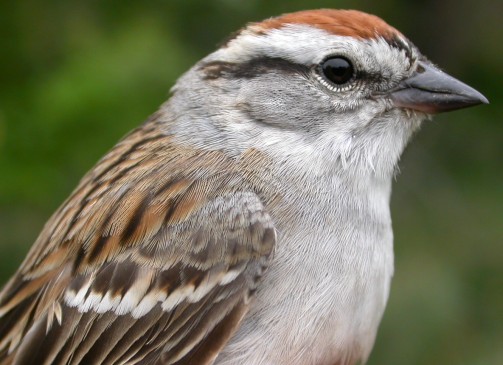
A relatively typical SY Chipping Sparrow, largely indistinguishable in this view from ASY.
Photo by Marcel Gahbauer,
McGill Bird Observatory (QC), May 2005
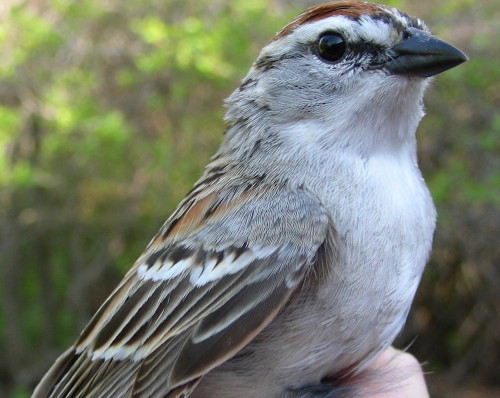
Another SY Chipping Sparrow, with what appears to be a somewhat less extensive crown
and paler wing, but even so, this view is far from conclusive.
Photo by Marie-Anne Hudson, McGill Bird Observatory (QC), May 2009
SY Chipping Sparrows show a molt limit between the greater coverts and the retained block of paler brown juvenile feathers comprised by the primary coverts, primaries, and secondaries. The outer primary coverts may be particularly narrow and pointed. The overall condition of the wing tends to be more worn than on ASY birds.
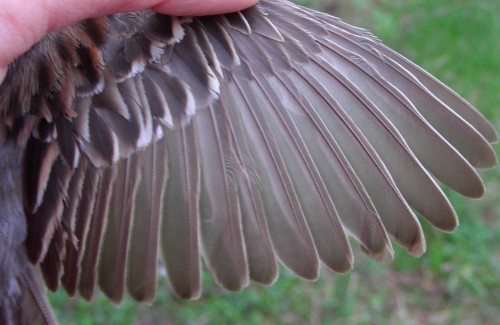
An SY wing in relatively good condition, but notice the uniformly pale brown block of primary
coverts, primaries, and secondaries, and the pointed and frayed primary coverts in particular.
Photo by Marie-Anne Hudson,
McGill Bird Observatory (QC), May 2008
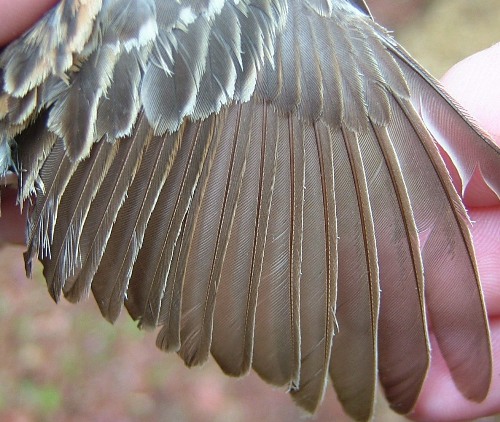
A much more worn SY wing, with extensive fraying on most feathers, and the outer primary
coverts again particularly pointed.
Photo by Peter Pyle, Howell Woods (NC), May 2006
The rectrices of SY birds tend to be more narrow and pointed, and are on average somewhat more frayed than those of ASY birds, though this can vary considerably.
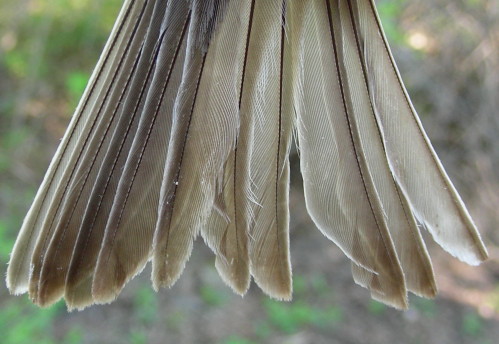
This tail is in relatively good condition, but does show the typical SY rectrix shape.
Photo by Marie-Anne Hudson, McGill Bird Observatory (QC), May 2009
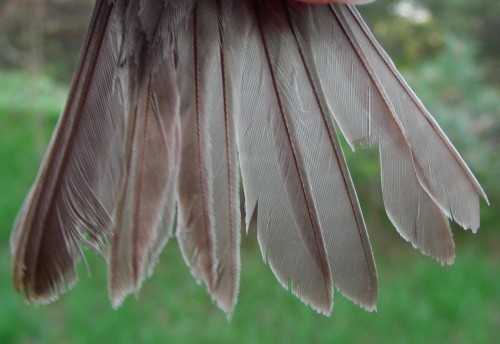
A somewhat more typically worn tail, showing fraying and some broken tips; the central
rectrices in this case are particularly narrow and frayed.
Photo by Marie-Anne
Hudson, McGill Bird Observatory (QC), May 2008
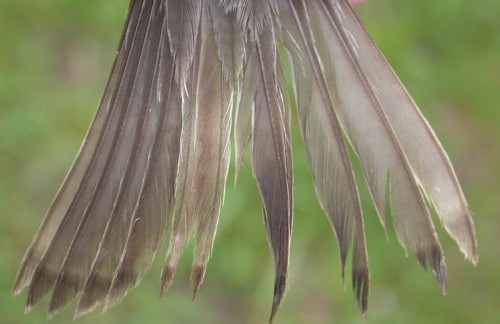
A rare case of extremely narrow and pointed rectrices.
Photo by Marcel Gahbauer,
McGill Bird Observatory (QC), May 2005
RETURN TO AGE/SEX
OVERVIEW
|
JUL - DEC: after-hatch-year
unknown |
AHY birds usually have more
rufous feathers on the crown than HY birds, but there can be overlap,
and the wing and tail provide more reliable indicators of age.
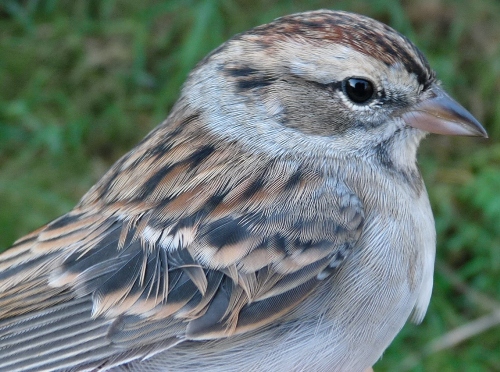
A typical AHY Chipping Sparrow, showing some remnant rusty feathers in the crown.
Photo by Marcel Gahbauer,
McGill Bird Observatory (QC), October 2009
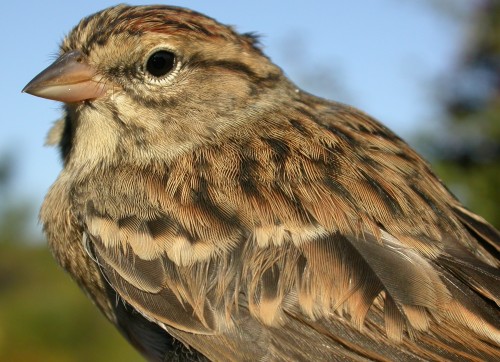
Another AHY, showing how the plumage can take on a richer brown tone in sunlight.
Photo by Marcel Gahbauer,
McGill Bird Observatory (QC), September 2005
There is no molt limit on AHY birds (although the darker greater coverts may suggest a pseudolimit). Primary coverts are typically broad and
rounded.
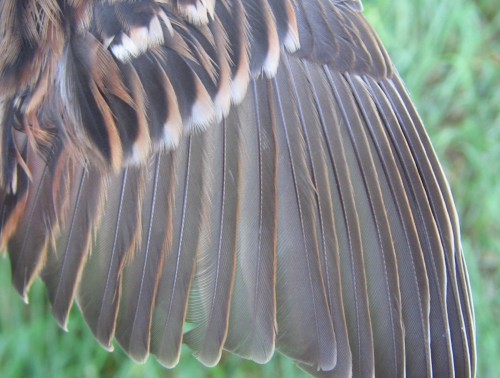
Photo by Marcel Gahbauer,
McGill Bird Observatory (QC), September 2005
Rectrix shape on Chipping Sparrows varies less by age than in some sparrows, but tends to be broader and more rounded on AHY birds.
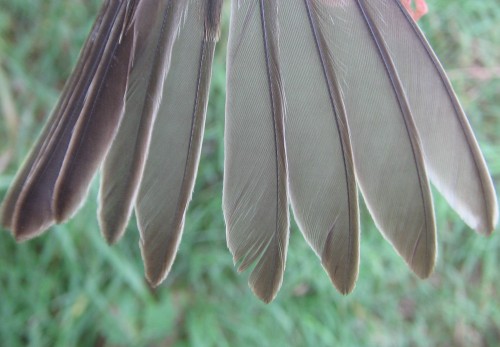
Although reasonably broad, these rectrices are rather pointed for an AHY bird and the tail
therefore does not provide good clues to age; this individual was aged by wing instead.
Photo by Marcel Gahbauer,
McGill Bird Observatory (QC), September 2005
RETURN TO AGE/SEX
OVERVIEW
|
JUL - DEC: hatch-year
unknown |
HY birds usually have fewer rufous feathers
on the crown than AHY birds, but there can be overlap, and the wing and
tail provide more reliable indicators of age. Appearance can be a bit variable, as some individuals retain some juvenile breast streaking into winter.
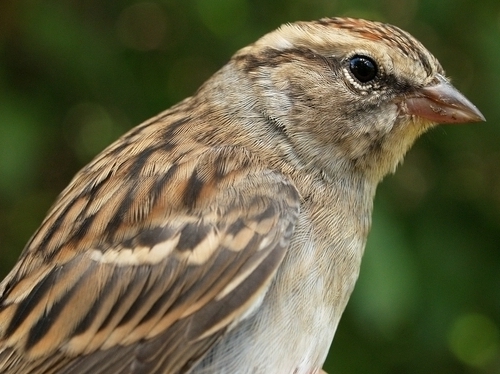
An HY bird already showing some rust in the crown.
Photo by Simon Duval,
McGill Bird Observatory (QC), September 2010
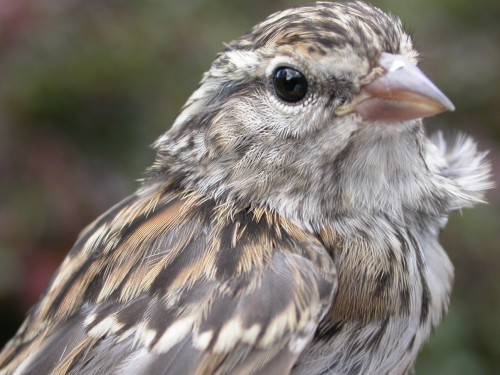
An individual with some streaking retained on the breast.
Photo by Marcel Gahbauer,
McGill Bird Observatory (QC), September 2005
There is a molt limit on HY birds between the replaced formative greater coverts and the retained block of juvenile primary coverts, primaries, and secondaries; however, the contrast can be subtle in fall when all feathers are still relatively fresh. The outer primary coverts on HY birds tend to be narrower than on
AHY birds.
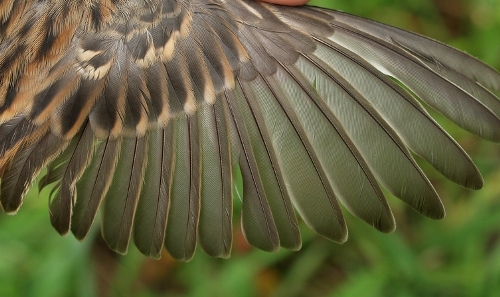
An example showing how subtle the molt limit can appear, but note the contrast between
the greater coverts and inner secondaries.
Photo by Simon Duval,
McGill Bird Observatory (QC), September 2010

An example from a bit later in fall, by which time there may already be a somewhat greater
contrast between the replaced and retained blocks of feathers.
Photo by Marcel Gahbauer,
McGill Bird Observatory (QC), October 2010
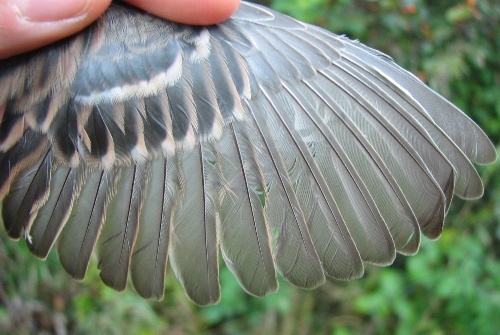
A more distinct example of the contrast shown by the molt limit.
Photo by Barbara Frei, McGill Bird Observatory (QC), September 2007
Chipping Sparrows have
somewhat pointed rectrices at any age, but the feathers are narrower for
HY birds. Uniform growth bars
across the tail are also often present.
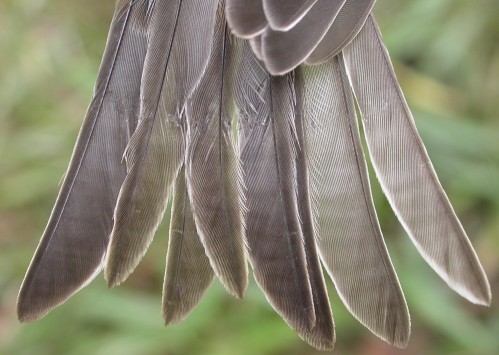
A typical HY tail, with narrow and pointed rectrices, distinct growth bars across the tail,
and the central rectrices already showing signs of wear.
Photo by Marcel Gahbauer,
McGill Bird Observatory (QC), September 2005
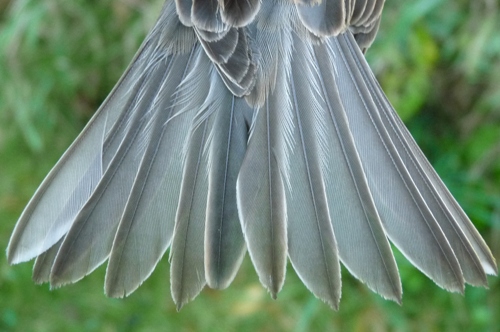
In this case, one of the central rectrices has been prematurely replaced, showing a distinct
contrast in colour and shape compared to the remaining juvenile rectrices.
Photo by Marcel Gahbauer,
McGill Bird Observatory (QC), October 2010
|
JUN - SEP: juvenile
unknown |
Juvenile Chipping Sparrows are easily aged by the fine streaking across the breast, but (where populations overlap) need to be examined closely to rule out Clay-colored Sparrow.
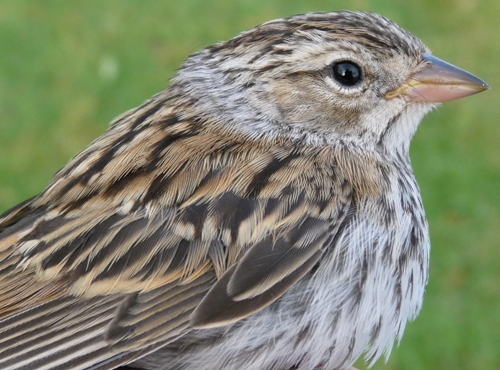
A typical juvenile Chipping Sparrow, heavily streaked below, and with just a hint of rufous
apparent in the crown.
Photo by Marcel Gahbauer, Cypress Hills Provincial Park (AB), August 2010
The primary coverts on HY birds are narrower than on
AHY birds, but when fresh on juvenile birds are usually not yet distinctly paler than the adjacent greater coverts.
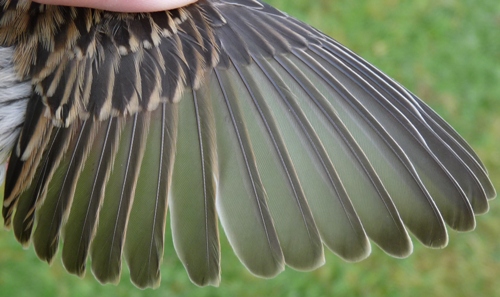
Photo by Marcel Gahbauer, Cypress Hills Provincial Park (AB), August 2010
Chipping Sparrows have
rather pointed rectrices at any age, but the feathers are narrower for
HY birds. However, when fresh (as on this juvenile) they may not appear distinctly different from those of an adult; the overall plumage of a juvenile is therefore best for ageing.
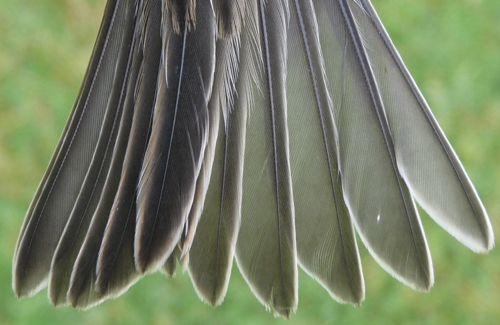
Photo by Marcel Gahbauer, Cypress Hills Provincial Park (AB), August 2010
RETURN TO AGE/SEX
OVERVIEW












































